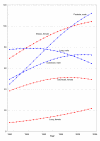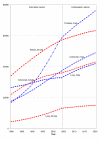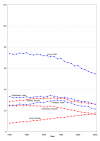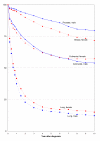German cancer statistics 2004
- PMID: 20175882
- PMCID: PMC2837012
- DOI: 10.1186/1471-2407-10-52
German cancer statistics 2004
Abstract
Background: For years the Robert Koch Institute (RKI) has been annually pooling and reviewing the data from the German population-based cancer registries and evaluating them together with the cause-of-death statistics provided by the statistical offices. Traditionally, the RKI periodically estimates the number of new cancer cases in Germany on the basis of the available data from the regional cancer registries in which registration is complete; this figure, in turn, forms the basis for further important indicators.
Methods: This article gives a brief overview of current indicators - such as incidence, prevalence, mortality, survival rates - on the most common types of cancer, as well as important ratios on the risks of developing and dying of cancer in Germany.
Results: According to the latest estimate, there were a total of 436,500 new cancer cases in Germany in 2004. The most common cancer in men is prostate cancer with over 58,000 new cases per annum, followed by colorectal and lung cancer. In women, breast cancer remains the most common cancer with an estimated 57,000 new cases every year, also followed by colorectal cancer. These and further findings on selected cancer sites can be found in the current brochure on "Cancer in Germany", which is regularly published by the RKI together with the Association of Population-based Cancer Registries in Germany (GEKID). In addition, the RKI made cancer-prevalence estimates and calculated current morbidity and mortality risks at the federal level for the first time. According to these figures, the 5-year partial prevalence - i.e. the total number of cancer patients diagnosed over the past five years who are currently still living - exceeds 600,000 in men; the figure is about the same among women. Here, too, the most common cancers are prostate cancer in men and breast cancer in women. The lifetime risk of developing cancer, which is more related to the individual, is estimated to be higher among men (48.5%) than among women (40.3%). In roughly rounded figures, therefore, about every second person in Germany develops cancer in the course of their lives. One in four men and one in five women die of cancer.
Conclusions: In recent years, population-based cancer registration in Germany has come significantly closer to the aim of the complete, nationwide coverage of cancer. The continuous improvements in the data situation help describe cancer development in Germany.
Figures




References
-
- Schön D, Bertz J, Görsch B, Haberland J, Kurth BM. Die Dachdokumentation Krebs - Eine Surveillance-Einrichtung der Krebsregistrierung in Deutschland (The Federal Cancer Surveillance Unit - an institution for monitoring cancer registration in Germany) Bundesgesundheitsbl - Gesundheitsforsch - Gesundheitsschutz. 2004;47:429–436. doi: 10.1007/s00103-004-0830-7. - DOI - PubMed
-
- Cancer in Germany, 2003-2004. Incidence and Trends. Sixth revised. Robert Koch Institute (ed.) and Association of Population-based Cancer Registries in Germany (Gesellschaft der epidemiologischen Krebsregister in Deutschland e.V., GEKID) (ed.). Berlin; 2008.
-
- Hentschel S, Katalinic A. (Manual of Population-based Cancer Registration) W. Zuckschwerdt Verlag, Munich; 2008. Das Manual der epidemiologischen Krebsregistrierung.
-
- Statistisches Bundesamt. Bevölkerung Deutschlands bis 2050 - Ergebnisse der 11. koordinierten Bevölkerungsvorausberechnung (Federal Statistical Office (2006) Germany's Population up until 2050 - Results of the 11th Coordinated Population Projection). Wiesbaden. 2006.
-
- DIMDI. (Conversion table between ICD-9 V 6.0 and ICD-10 V 1.3), Version 3.0. Deutsches Institut für medizinische Dokumentation und Information. Köln; 1999. Überleitungstabelle zwischen ICD-9 V 6.0 und ICD-10 V 1.3.
MeSH terms
LinkOut - more resources
Full Text Sources
Miscellaneous

